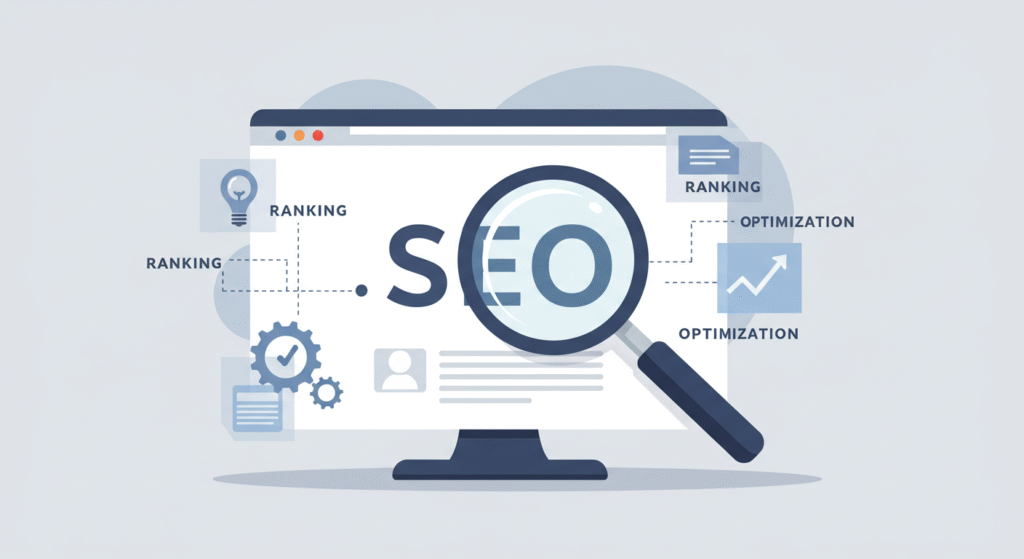Why SEO Is the Secret Ingredient for Online Success
Imagine you’ve opened the best coffee shop in town. Your espresso is smooth, your pastries flaky perfection—and yet, the café is empty. Why? Nobody can find you.
That’s exactly what happens online when your website isn’t optimized for search. You may have the smartest service, the most insightful blog, or the sleekest product catalog—but if Google (and people) don’t know you exist, it’s like throwing a party where the invitations never got sent.
That’s where SEO (Search Engine Optimization) comes in. Think of SEO as the art-and-science combo that makes your website more discoverable, trustworthy, and aligned with what people are actually searching for. Done right, SEO gets you ranking higher in search results, attracts the right visitors, and builds organic growth that doesn’t rely solely on paid ads.
In this beginner-friendly roadmap, you’ll learn:
- What SEO is & why it’s crucial in 2025.
- How search engines work behind the scenes.
- The three pillars of SEO: on-page, off-page, and technical.
- A clear step-by-step beginner roadmap.
- The new trends reshaping SEO: AI results, zero-click searches, Core Web Vitals, entity SEO.
- Common mistakes to avoid.
By the end, you won’t just “know what SEO is”—you’ll walk away with a roadmap you can start using today.
What Is SEO and Why Should Beginners Care?
SEO = Search Engine Optimization.
In plain English: SEO is about making your website easy to find, easy to understand, and easy to trust for both people and Google.
When someone searches “best running shoes for beginners,” Google sorts through billions of pages. Rankings depend on relevance, depth of content, usability, speed, authority, and more recently—user experience signals.
2025 Update: Google now reinforces E‑E‑A‑T (Experience, Expertise, Authoritativeness, Trustworthiness). Articles that feel low-value or obviously AI‑generated without human editing are slipping in rankings.
Key Benefits of SEO in 2025
- Visibility & Click Share: The #1 organic result still captures ~39–40% of all clicks (Sistrix, 2024).
- Trust & Authority: Being on page one builds credibility before anyone even clicks.
- Cost-Effectiveness: SEO keeps working even after ads stop.
- Better UX: SEO improvements like fast load speed and structured content create a smoother visitor experience.
- Market Shifts: ~62% of traffic now comes via mobile and ~58% of U.S. searches are “zero-click.”
- AI Overviews: As of 2025, 30%+ of Google searches show AI summaries. Optimizing for snippets and schema helps your content appear (and get cited) inside these summaries.
How Do Search Engines Work? (Beginner Version, 2025 Updates)
Think of Google as the internet’s smartest librarian.
- Crawling: Bots (“spiders”) search websites for new and updated content.
- Indexing: Content gets stored in Google’s giant database.
- Ranking: Algorithms decide which results are most helpful—evaluating factors like intent, quality, authority, and usability.
Key 2025 Changes:
- Mobile-first indexing is complete. Google uses your mobile site as the default.
- Core Web Vitals update: FID (First Input Delay) has officially been replaced with INP (Interaction to Next Paint) as the responsiveness metric.
- AI Overviews & Snippets: Many queries get answered directly in search, which means it’s not just about blue links anymore—it’s about visibility across SERP features.
The Pillars of SEO (and What They Look Like Now)
1. On-Page SEO (Content & Site Optimization)
Your direct influence zone.
- Keywords & Intent: Use conversational, long-tail, and voice-search variations.
- Helpful Content: Depth, originality, and clear intent-matching.
- Featured Snippets & Schema: Optimized structure improves chances to appear inside snippets and AI summaries.
- Titles & Meta Tags: Compelling, clear, intent-aligned.
- Internal Linking: Build topic clusters that signal depth.
- Image Optimization: Compressed, with descriptive alt text.
- 2025 Pro Move: Add schema for FAQs, How-To guides, Products, and Author profiles. Google increasingly elevates content with clear authorship.
2. Technical SEO (The Behind-the-Scenes Foundation)
The invisible scaffolding of rankings.
- Mobile-first layout & Core Web Vitals (LCP, CLS, INP).
- HTTPS for security.
- Crawlability: Clean sitemap, no broken redirects.
- Schema Markup: Boosts chances in rich features.
- 2025 Pro Move – Entity SEO: Google now maps content to entities (brands, authors, places). Link to verified profiles (LinkedIn, Google Business Profile, Wikipedia) to strengthen authority.
3. Off-Page SEO (Authority Signals)
What other sites say about you.
- Backlinks: Quality > quantity.
- Google Business Profile reviews boost local SEO.
- PR & Mentions: Brand credibility helps rankings.
- Collaborations & Guest Posts: Build relevance in context.
- 2025 Insight: Social proof matters more. Active, consistent brand presence across platforms reinforces trust signals.
How to Start with SEO in 2025 (A Beginner Roadmap)
- Understand Search Intent → Know if your audience wants information, solutions, or products.
- Do Keyword Research → Tools like Google Trends, Keyword Planner, AnswerThePublic help you start.
- Optimize One Page at a Time → Match intent in titles, content depth, and meta descriptions.
- Fix Technical Basics Early → HTTPS, mobile speed, sitemap setup.
- Track & Adapt → Use GA4 & Search Console to measure queries, CTR, AI Overview impressions, snippet visibility, and user behavior.
Common SEO Mistakes Beginners Make (and New 2025 Traps)
- ❌ Keyword stuffing.
- ❌ Thin content.
- ❌ Ignoring mobile UX.
- ❌ Not using analytics.
- ❌ Ignoring snippets/zero-click search.
2025 Pitfalls to Avoid:
- Unedited AI content farms: Google’s June 2025 update downgrades “low-value, generic AI text.”
- Missing author profiles/bios: Lower E‑E‑A‑T if trust signals are absent.
FAQs: Beginner SEO Questions in 2025
How long does SEO take to work?
Small improvements show in 2–3 months; bigger gains in 4–9 months.
Do I need an SEO expert immediately?
Not for basics. Experts add most value in competitive niches or complex websites.
Is SEO better than ads?
They’re complementary: ads = quick wins, SEO = sustainable traffic growth.
Can I SEO without coding?
Yes. CMS tools like WordPress with Yoast/Rank Math handle most basics.
What tools should I start with?
Free: Google Search Console, GA4, PageSpeed Insights, Trends.
Pro (2025+): Surfer SEO, Clearscope—helpful in optimizing for AI Overviews.
Comparison Table: Free vs Paid SEO Tools in 2025
| Feature | Free Tools (2025) | Paid Tools (Advanced/Pro) |
|---|---|---|
| Keyword Research & Intent | Google Keyword Planner, Google Trends, AnswerThePublic | SEMrush, Ahrefs, Moz, Surfer SEO |
| SERP / Snippet Visibility | Google “People Also Ask,” Search Console Queries | Clearscope, MarketMuse, Semrush SERP Features |
| Site Performance Audits | Google PageSpeed Insights, Lighthouse, Web Vitals Extension | GTmetrix, Sitebulb, SEMrush Site Audit, Screaming Frog |
| Backlink Analysis | Basic links in Search Console, free Ahrefs/Moz preview | Ahrefs full database, Majestic, Moz Link Explorer |
| Rank Tracking | Manual Google checks, Ubersuggest free tier | Ahrefs Rank Tracker, SEMrush Position Tracking, BrightEdge |
| Content Optimization | Yoast SEO (basic), RankMath (basic), Hemingway for readability | Surfer SEO, Clearscope, MarketMuse |
Final Thoughts: Unlocking the Power of SEO
SEO in 2025 is about more than keyword tricks—it’s about showing that you’re real, trustworthy, and helpful in a noisy, AI-driven web.
- Think mobile-first and intent-first.
- Optimize for snippets and AI Overviews, not just the classic 10 blue links.
- Build a sharp technical foundation (Core Web Vitals + entity SEO).
- Strengthen your brand footprint across platforms.
- Don’t chase “quick hacks.” Focus on usability, authority, and value.
Pick one small step today—add structured data, speed up mobile load, or write/update an article with author bio and helpful detail. Over time, your site doesn’t just exist online—it actually gets found.
Your future self (and your Google ranking) will thank you.

